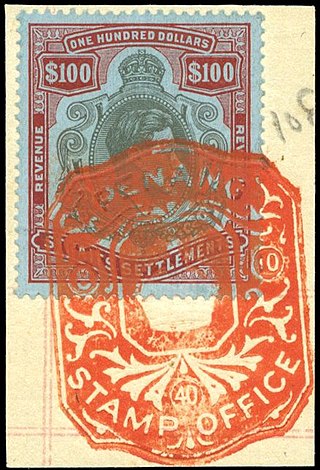Malaysian definitive stamps
Stamps are issued for all states of Malaysia, mainly definitive stamps of the same design, but with their respective state names. Definitive stamps are issued for use in all states only in high denominations (from 25 cents to 10 dollars). As for the low denominations (from 1 to 20 cents), stamps are produced for the individual states.
- Orchid and bird definitives, 1965
During 1965 Malaysia issued its first definitive stamps. The stamps featured orchids for the State low values and birds for the Malaysia high values. Each State had its own set, identical with the exception of the State name and Rulers portrait or State crest as applicable. The eight high values were printed in portrait format, featuring Malaysian birds, and had 'MALAYSIA' printed on them in place of State names.
- State low values, 15 November 1965
The stamps were designed by A. Fraser-Brunner.
The thirteen states issuing stamps were: Johore, Kedah, Kelantan, Malacca, Negri Sembilan, Pahang, Penang, Perak, Perlis, Sabah, Sarawak, Selangor, and Trengganu.
Proofs were also produced for Singapore, but the stamps were never issued as Singapore withdrew from Malaysia, becoming an independent country.
The stamps were printed in landscape format by Harrison & Sons in England in two panes of 100, 10 x 10, with the cylinder numbers appearing on the right of the bottom margins, one for each colour, the left pane being numbered 1A and the right pane numbered 1B. There were two types of gum in use, Gum Arabic and PVA, the differences are clear to see, Gum Arabic being glossy and PVA matt. The colours were not produced by the standard four colour lithography method, cyan, yellow, magenta and black, but had dedicated colours as required by each value printed in photogravure. The left of the bottom margin contained colour check blocks, one for each colour surrounded by a black box, this black being for the State customisation black cylinder. The first issues were on paper watermarked 'Multiple SPM' upright and comb perforated 14 1/2. A few values appeared later on with watermark sideways and then later again without watermark.
The values issued were 1 cent, 2 cents, 5 cents, 6 cents, 10 cents, 15 cents and 20 cents. Various proofs exist showing the individual colours and combined up to full colour proofs. In addition, each value was produced on Harrison proof cards in full colour.
From the outset, there were problems with printing this issue as there are a number of missing colours present, in some cases more than one colour, indicating poor quality control. Some of the missing colours are now very difficult to find as in some cases only few stamps on a sheet were affected, generally 10 or less. Many of these varieties were the result of one of the printing colour supplies being interrupted during the print run and restarting, causing a missing colour on one or more columns.
- Missing colours are known as follows:
Johore: 1 cent grey, 5 cents yellow, 10 cents green, 15 cents green and 20 cents bright purple.
Kedah: 1 cent grey, 2 cents yellow, 2 cents green, 5 cents black (country name & portrait), 5 cents red, 10 cents red, 10 cents green, 20 cents bright purple and 20 cents yellow.
Kelantan: 1 cent magenta, 10 cents red, 20 cents bright purple and 20 cents yellow.
Malacca: 5 cents yellow and 5 cents red.
Negri Sembilan: 5 cents yellow and 5 cents red.
Pahang: 1 cent grey, 5 cents red and 10 cents red.
Penang: 5 cents yellow, 5 cents red, 5 cents blue, 5 cents blue and yellow, 6 cents yellow, 15 cents green, 15 cents black, 20 cents bright purple and 20 cents yellow.
Perak: 2 cents dark green, 5 cents yellow, 10 cents red, 15 cents black, 15 cents magenta and 20 cents bright purple.
Perlis: None.
Sabah: 2 cents dark green.
Sarawak: 1 cent grey, 2 cents black, 2 cents dark green, 2 cents yellow-olive, 6 cents black (country name & shield) and 10 cents red,
Selangor: 1 cent magenta, 2 cents yellow, 5 cents yellow, 5 cents red, 10 cents red, 15 cents green, 20 cents bright purple and 20 cents green.
Trengganu: 15 cents black (country name & portrait) and 20 cents bright purple.
Eight values were issued for the medium and high values featuring Malaysian birds. The values were 25 cents, 30 cents, 50 cents, 75 cents, $1, $2, $5 and $10 and were intended for use in any Malaysian State. As with the low values, they were printed in two panes of 100, 10 x 10 with cylinder numbers 1A and 1B for the left and right pane, watermarked 'Multiple PTM upright' perforated 14 1/2. Various proofs exist showing the individual colours and combined up to full colour proofs. In addition, each value was produced on Harrison proof cards in full colour. As with the low values, missing colours can be found on a few values and inverted watermarks on the 25 cents, 30 cents, 50 cents, $1, $2 and $5 values.
- Missing colours are known as follows:
30 cents, blue, 30 cents yellow, 50 cents yellow, 50 cents scarlet.
Constant flaws can be found on most values, some of them being catalogued by Stanly Gibbons for the first time in 2013.
There were seven values for each state and eight high values inscribed 'Malaysia'. The states were: Johore, Kedah, Kelantan, Malacca, Negri Sembilan, Pahang, Penang, Perak, Perlis, Sabah, Sarawak, Selangor, and Trengganu. The original state issues were printed by Bradbury Wilkinson & Sons in the United Kingdom, in sheets of 200 in two panes of 100, 10 x 10, for the values of 1c, 2c, 5c, 6c, 10c, 15c and 20c. The printing process was lithography.
Colour separation proofs for each individual colour were printed for each value, and the colours combined in a process that eventually produced a full colour proof. These proofs were produced, initially, in small units, four or so and later as full sheets. This printing took place to ensure that all colours printed correctly when combined and also registered correctly. The more common sheet proofs can be easily identified from the smaller units as the latter have white borders. The stamps printed as sheets had a design that allowed for 'bleeding' between each stamp, printing over the perforations. Each value had two separate black colours, the first was applied as detail for the butterfly and the stamp value, being common for all States. and the second for the State name, Rulers portrait and/or State coat of arms, this being the 'customising' colour for the base stamps.
In addition to sheet stamps, two values, 10 cents and 15 cents, were produced as coil stamps for use in vending machines in several locations throughout Malaysia. The designs were similar to the state values, but produced with 'Malaysia' in place of a state name as they were for use in any state. These coils were printed by Harrison & Sons in photogravure. From the start, the coil stamp machines proved to be inefficient at dispensing the correct values for the money tendered, possibly due to humidity affecting the stamps. Due to these problems, the machines were dispensed with quite soon after they commenced their duty. As a result, commercially used examples of both values are scarce. During 2006 a variant of the gum was identified. It is brown, with a clear 'ribbing' effect. This may have been a trial to overcome some of the problems with the machines, the ribbing possibly helping to prevent curling of the individual stamps. Harrison Proof Cards exist for both values with an imperforate stamp in full colour on each.
During 1978, unannounced reprints for some state values were issued printed in photogravure by Harrison & Sons, the same printer that produced the coil stamps earlier. Some of these reprints are quite scarce, particularly the Perlis 10 cents and Sabah 20 cents values, as they were replaced by the new issue of Flowers and Animals the same year, and the new issue had not been announced by the post office. Once again, the stamps were printed in sheets of 200 in two panes of 100, 10 x 10. Unlike the Bradbury Wilkinson printings, these sheets had cylinder numbers in the bottom right margins, one for each colour and numbered 1A for the left pane and 1B for the right. These stamps can easily be separated out from the Bradbury Wilkinson printings, as photogravure produces edges with a 'fuzzy' look, caused by the photographic process when producing the printing cylinders. This can clearly be seen on the edges of the word 'Malaysia'. Bradbury Wilkinson printings have clear, straight edges. There are also differences in shade, but these are unreliable. There were two reprints, not all values being reprinted twice, and new values produced during the second printing. It is this printing that produced the scarce 10 cents value. The only proofs that have appeared to date are single full colour proofs on Harrison & Sons presentation cards, all values existing. It is considered that only two each of these cards would have been produced, one for the printers record and one for the Malaysian Post Office in Malaysia.
- Agricultural and fruits definitives, 1986
During 1986, a new set of definitives featuring agricultural produce and fruit stamps were issued, seven low values for each State and eight medium and high values inscribed 'Malaysia' for use in any State. This issue proved to be the most complex ever produced by Malaysia, lasting for over 14 years, the last printing in the original format taking place during 2000. The issue is notable for the perforation, gum and watermark varieties. The low values were identical for each State, except for the state name, state crest and ruler, or state crest only for those States without a ruler. The stamps were printed in five colour lithography, cyan, yellow, magenta and black with grey for highlighting various areas and a browny-grey shade for the background panel. They were printed on phosphorised 'Multiple SPM' paper with a wavy pattern, in sheets of 100, 10 by 10 and had pink gum and were perforated 12 by 12. The low and medium values were printed by 'Security Printers Malaysia' in Petaling Jaya, near Kuala Lumpur. The four high values were printed by Harrison & Sons in the United Kingdom. The low values had plate numbers, one for each colour used for printing, in the top left, top right, bottom left and bottom right of each sheet, in the format 1A, 1A 1A etc., with colour dabs above or below each series of plate numbers.
The seven values issued for each state were 1 cent, 2 cents, 5 cents, 10 cents, 15 cents, 20 cents and 30 cents.
The 1 cent featured Coffee The 2 cents featured Coconuts The 5 cents featured Cocoa The 10 cents featured Black Pepper The 15 cents featured Rubber The 20 cents featured Oil Palm The 30 cents featured Rice



























